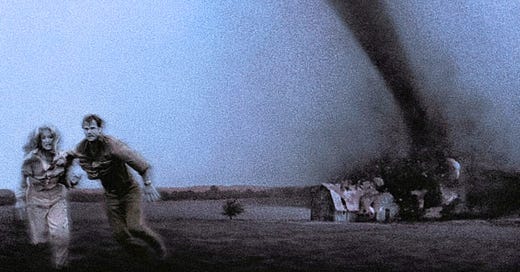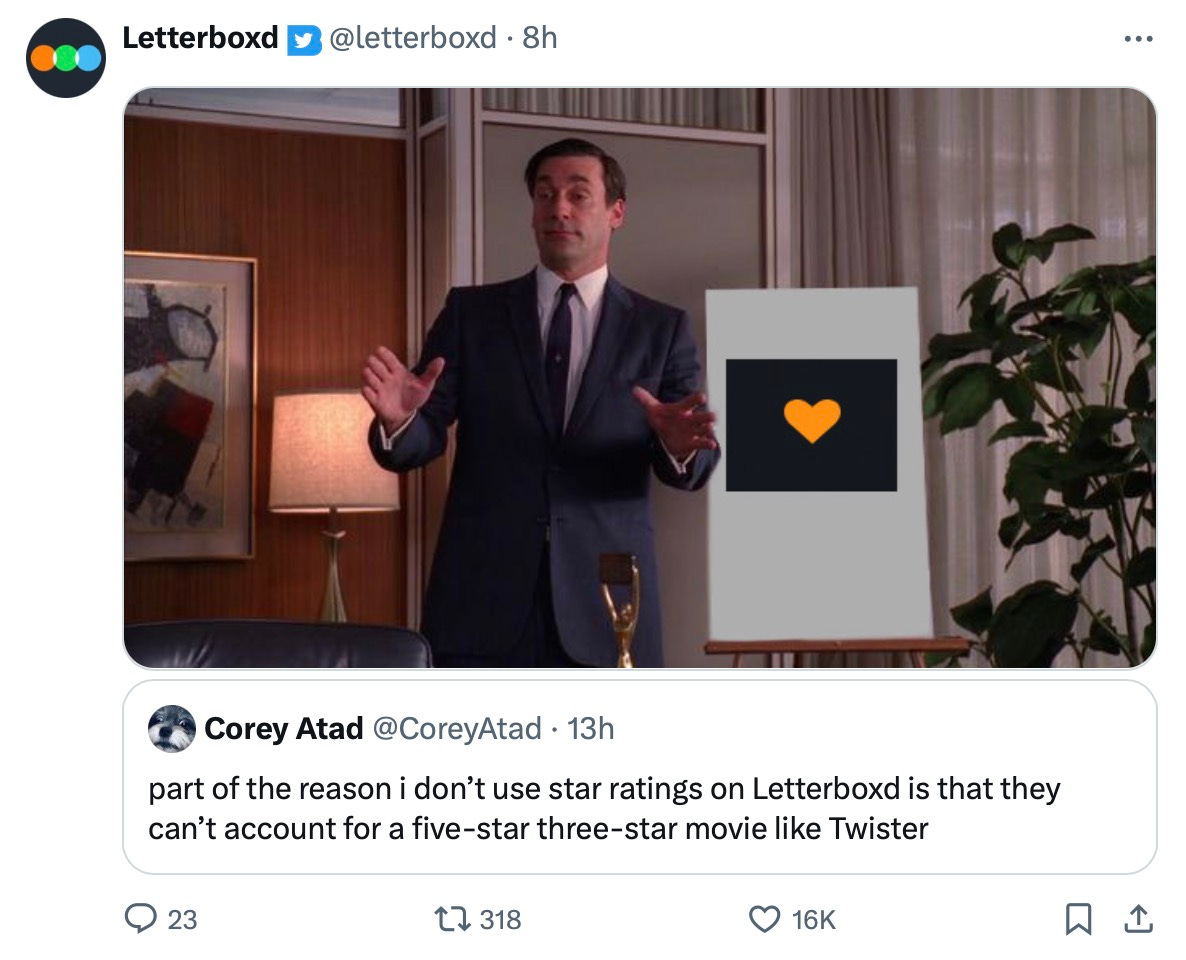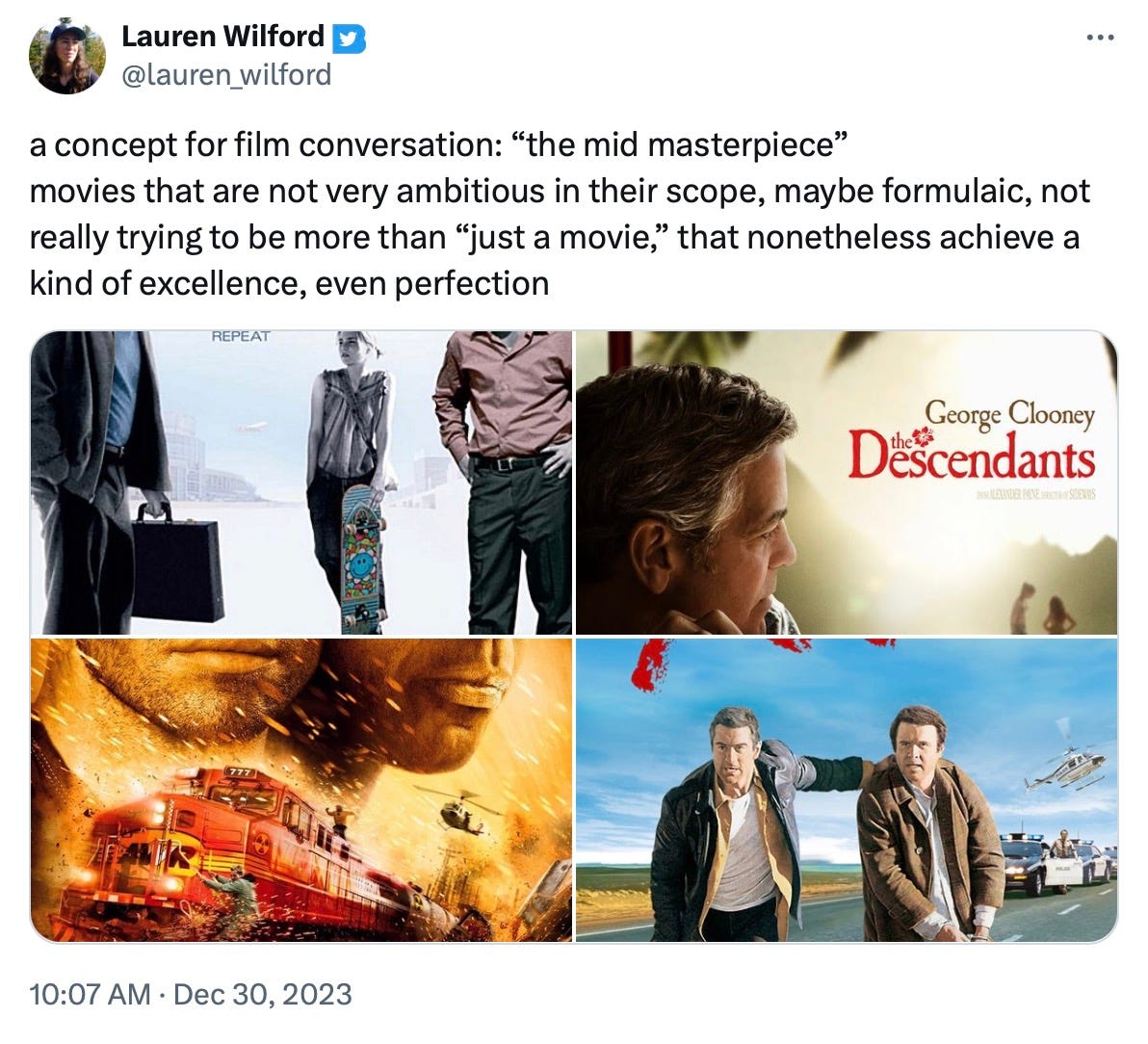This post was originally for paid subscribers only. I am now making it available for free, so readers can get a taste of the Five-Star Three-Star Cinema column before choosing to sign up for a paid subscription.
The other day, in anticipation of Twisters, the blockbuster sequel about to save cinema, I rewatched the original Twister. I’d last seen it several years ago, when the TIFF Cinematheque screened it on a 35mm print as part of their Steven Spielberg retrospective (he produced it). I’ve always loved Twister. I loved it as a kid in the ‘90s. I loved it in the years after, when I’d catch it on cable. I loved seeing it on the big screen for the first time on a beautiful print. And I loved it again this week, in its new 4K remaster. In fact, my persistent love for the movie had blinded me to the fact that a lot of people think it’s pretty mediocre, or even outright bad. I do not understand that opinion. It’s a perfect kind of Hollywood entertainment: a brilliantly simple premise sold by the title alone that completely lives up to all the absurdity that implies, written with classic studio clarity, built on the bones of old screwball romances, with an excellent cast delivering fun, distinctive performances, amid a succession of thrilling set pieces featuring groundbreaking effects work that looks better these almost 30 years later than a lot of the CGI-filled nonsense we’re forced to endure today. It is perfect, as I said, at being exactly what it is: a three-star movie.
Which prompted me to tweet out a half-joking tweet. I wrote, “part of the reason i don’t use star ratings on Letterboxd is that they can’t account for a five-star three-star movie like Twister.” It’s actually a joke I’ve made in various forms before. I certainly didn’t think I was being that clever. But clearly it was funny enough to warrant a response from the official Letterboxd account: an image of Don Draper putting on display the movie logging platform’s cute little orange “like” heart.
It made me laugh. As it happens, that is actually how I use Letterboxd. Whenever I log a film, I always leave a review (though sometimes that review is just a few words of little insight like, “that rocked”) and then I either throw the movie a heart or I don’t. Truth be told, I’m good enough at picking the movies I want to watch that most things I put on get a heart from me. When I venture out to the Cinematheque or some other rep screening, chances are it was a movie programmed for good reason, such that even if it wasn’t entirely my cup of tea, I throw it a heart anyway out of general appreciation or admiration. The heart, to me mind, represents nothing more than whether I ultimately felt it was worth my time, and I’m not too precious about it. Hell, I gave Night Swim a heart despite it being kind of a bad movie, if only because I had a good time at the theatre with its silliness.
But I don’t do star ratings. At one time I tried, having felt the peer pressure, but I just couldn’t bring myself to do it for long, and even went back and deleted what few ratings I’d given movies. I don’t like rating movies, never have. There’s something false in the process of it. As thought art can be assessed by some clean metric, or as though a few stars out of five can properly convey my feelings about a film. It’s bad enough that words are insufficient, why would I want someone to look at my three-star rating for a movie like Twister and assume they understand anything about my relationship to it?
Thing is, my tweet was a joke of sorts—in a joking spirit, at least—and I really do hate star ratings, but Twister is a three-star movie. It’s a five-star three-star movie.
When Letterboxd gave my silly comment a boost to its over 600,000 followers, I started getting bombarded with reaction—some of it quite assholeish and annoying—from people who really had no idea what I was talking about. The most common interpretation assumed I believed Twister was some kind bad movie that was also just so fun that it deserved a perfect score in my heart, with many calling me a coward for not following said heart (despite my giving it a heart on Letterboxd, of course). “A five-star three-star movie is five-star movie!” said one user. I get the impulse, and perhaps in my heart of hearts, Twister is a perfect movie.
And Twister is a perfect movie… it’s perfect at being mid.
Late last year, the wonderful Lauren Wilford, writer at Bright Wall/Dark Room and co-author with Ryan Stevenson of The Wes Anderson Collection: Isle of Dogs, forwarded her theory of the “mid masterpiece.” In her own jokingly imprecise construction, that included films like Matchstick Men, The Descendants, Unstoppable and Midnight Run. She also cited The Holdovers as another mid masterpiece (Alexander Payne has made a few of these, in truth). “It’s not an ambitious movie but it’s a simple thing done with care and attention.” I know exactly what Wilford was talking about, and as she pointed out to me, there’s clear relation between the mid masterpiece and the five-star three-star movie. Still, there is a distinction in my mind, if I’m to take all this silliness a bit too seriously. The mid masterpiece, as Lauren proposes, is a kind of movie whose ambitions are small in some crucial way. It’s not out to reinvent the wheel, or the movies. Yet, as the word “masterpiece” implies, it somehow transcends. In Payne’s films, the transcendence comes from the care and attention Lauren describes. In a movie like Unstoppable, it comes from the very real artistry Tony Scott was bringing to his work, particularly there, just before the tragic end of his life.
Unstoppable, you see, is a real five-star movie, such that stars even mean anything. It’s not merely that it’s a perfect movie (though, it is), but that its achievement stretches beyond the confines of its hilarious premise in which a train the length of the Chrysler Building barrels toward a city at top speed, threatening to blow it up, with Denzel Washington and Chris Pine the working class heroes on board to stop it. That should be a three-star movie at best in any sane universe, but in our universe it’s a film made with so much passion and almost experimental visual craft, which Scott had been honing for years at that point in films like Domino and Deja Vu, that to call it only a three-star movie would be a failure to recognize the possibilities of action cinema as real art.
That is not true of Twister, though. These are movies, they’re all art, sure sure, don’t start coming at me. But let’s be real about what Twister is. It’s workman-level stuff made by a great journeyman director of his time, who had previously transcended the goofy action movie with Speed (a film whose strangeness is little remarked upon despite being the film’s true beating heart). Jan de Bont was also the cinematographer on Die Hard a film whose perfection and whose genre-defining quality place it well beyond any nonsensical Film Twitter constructions as mid masterpiece. It is, simply a masterpiece. But Twister is not a masterpiece. It does not transcend. Rather, it is perfect in its mediocrity, content to show you a lot of tornadoes in a solid, thrilling 113 minutes. Bill Paxton and Helen Hunt are really fun in it. As are the supporting cast of Jamie Gertz, Philip Seymour Hoffman, Cary Elwes, Alan Ruck, Lois Smith and all the rest. The script is absolutely idiotic, but using His Girl Friday as a template within an action-adventure is clever enough to bring humour and a light touch throughout. The action is well-directed and well-conceived, with some cool images, but it’s also kind of just a lot of cars chasing wind, more interested in showing the audience visual effects that could not have been done before computer animation than actually being inventive. It’s an easy movie, a memorable one, and it’s a great time, but it’s not truly great.
There are many such movies. One Twitter user, who clearly understood me, offered up Con-Air. Fuck yes. Con-Air is a five-star three-star movie. Presumed Innocent is a five-star three-star movie (and the new TV series might reasonably be called a five-star three-star show). A lot of film noirs from the ‘40s and ‘50s fit the bill, too. Cranked out on the cheap, factory-like, by directors who knew how to make a movie, with typical crime movie scripts and crime movie dialogue of the era. Perfect entertainments, but lacking the panache that made the true noir masterpieces stand out as something more than mere B-movie. Indicator’s Columbia Noir box sets are a great source. Go watch Don Siegel’s The Lineup (great, but not Don Siegel’s The Killers great), or Richard Quine’s Pushover, or Joseph H. Lewis’s The Undercover Man. Though probably the best example is Gordon Douglas’s Walk a Crooked Mile, an FBI propaganda film from the Red Scare era done with a kind of documentary style not uncommon for that time, with a mystery spy plot and a crazy shootout at the end. It’s not great, but it’s a great fucking time. A perfect middle-of-the-road picture. A five-star three-star movie.






